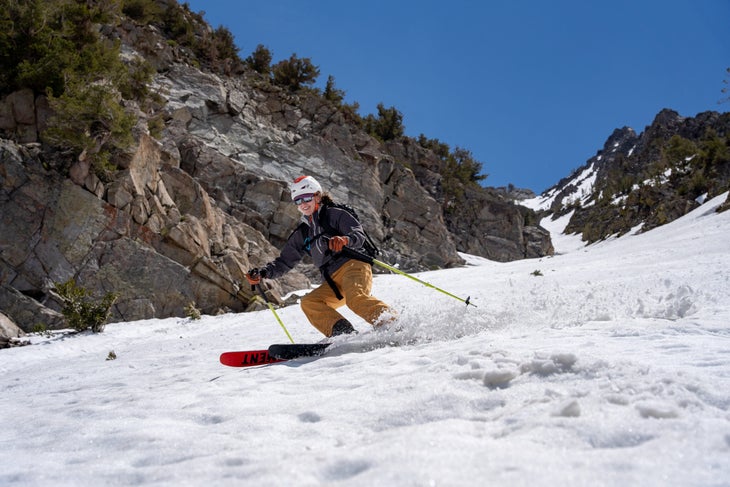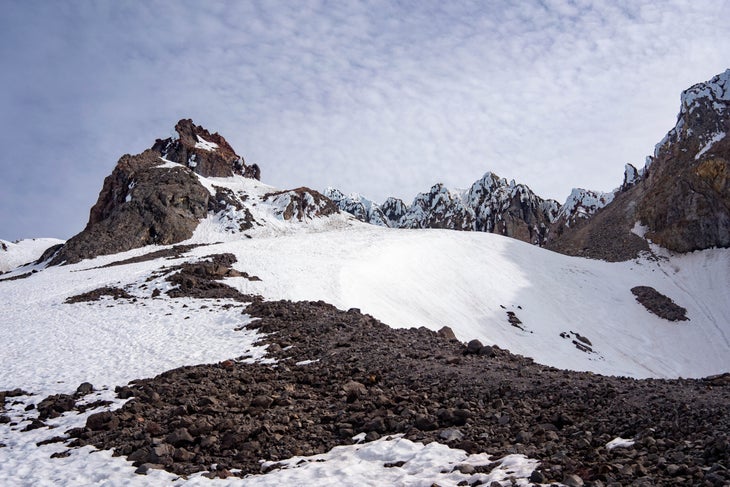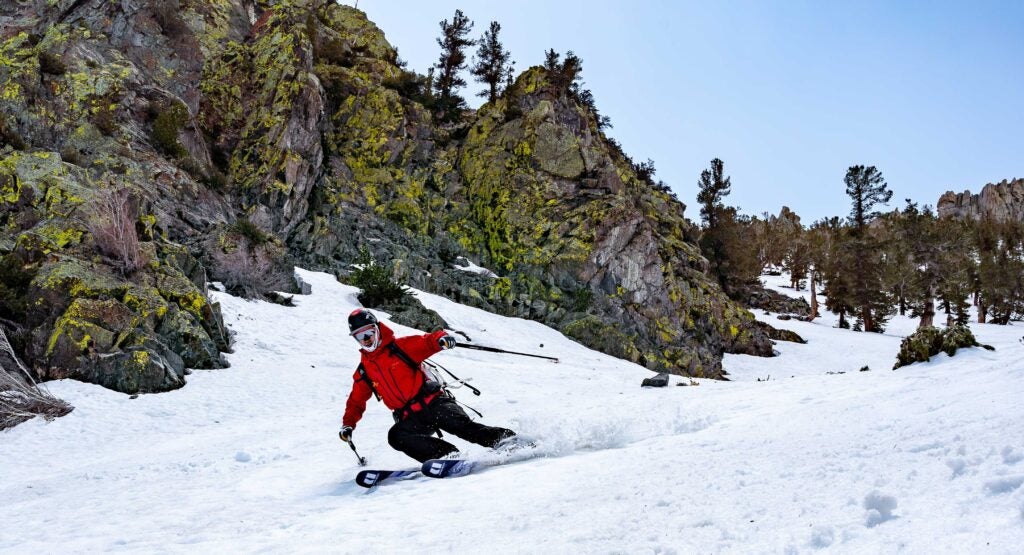No products in the cart.
Outdoor Adventure
The Definitive Ranking of the Best and Worst Snow Conditions
Heading out the door? Read this article on the Outside app available now on iOS devices for members!
Download the app.
I spent my first full ski season at Alta, Utah, waiting tables and skiing the deepest snow of my life. I arrived late in January, but by working breakfasts and dinners I managed to clock 80 days on snow skiing between my shifts. In a twist of irony, the deep powder snow was so good that it wasn’t until I left Alta that I realized I’d never really learned how to ski.
Moving to Mammoth Lakes, California turned out to be an exercise in learning to use my edges. The next three years produced pitiable snowfall totals and some of the strangest surface conditions I’ve ever encountered. I skied knife-hard planar snow, buffeted firm by the wind. When it switched directions, the gales created a wildly uneven wave texture called sastrugi that is extraordinarily difficult to navigate. Rains and freeze-thaw cycles created strange frozen nodules on the surface that we called chicken heads.
The crucible of shitty conditions forged me into a much better skier, and I developed a taxonomy of snow textures both strange and sublime. Years in the Sierra prepared me for this moment: Publishing the definitive ranking of snow conditions for skiers and riders everywhere. I will not be taking any questions at this time.
Blower Powder Reigns Supreme
Surprising absolutely no one, sitting atop the throne of skiable conditions is that sweet, low-density powder. It’s called “blower” because when you pick it up in your palms and blow it like a dandelion, it scatters into the crystalline ether. Skiing real cold smoke is the closest we have to oblivion, in the Buddhist sense of the word. As they say on TikTok: No thoughts. Just vibes.
Wind Buff: A Surprise Runner-Up
Many skiers may be unfamiliar with this runner up, but Mammoth is known for this recycled powder that coats our faces and chutes with an ultra-fine magical carpet. When the wind picks up snow on the windward sides of mountains and tumbles it through the air, the crystals break apart, resulting in snow far finer than powder flakes. When the wind-tossed grains of snow settle on the leeward sides, they form a thin layer atop the snow surface that you can carve on steep terrain as if it were groomed. The best part? The more people ski it, the better it typically gets.

Corn: The Crown Jewel of Spring Skiing
Spring in the Sierra is all about chasing the corn cycle—an elusive window when the sun and air warm the firm morning ice and softens it to a perfect texture. Arrive too early, and you’ll have to sit and wait, or brave the firm snow. Arrive too late, and the sun cooks the surface into isothermic slop. But when you nail the timing, the rock-solid snow softens into crystals that look very much like kernels of corn. When the corn is just right over a firm base, you can rip Super-G turns down large backcountry faces with remarkable consistency. It’s one of the greatest feelings I know, and it was hard not to put at the very top in this ranking on ski conditions.
Chalk: Synonymous with Stability and Confidence
Rare where I live, chalk is the result of consistent cold temperatures without precipitation combined with mild winds that dry out and soften leftover snow. The best part of skiing chalk is the energy you can generate by pressuring it with a ski at a high edge angle. You can rail very fast turns on chalk because of its easy and consistent nature, and it sticks around as long as the weather does. In California that can be a very long time.
Slush: Powder You Can Ski in a T-Shirt
We can ride chairlifts into July at Mammoth, and recently, even August. The low sun angles and higher temperatures create ideal conditions high on the mountain. While the lower elevations go to hell, the upper reaches turn into a playground of soft snow. Lots of die-hard skiers will tell you that the best part of their season is weaving through slushy moguls in Hawaiian shirts and bikinis in the spring.

Sierra Cement: We Ski It Because We Have It, Not Because We Love It
In a mountain range not far from the Pacific, our snow rarely comes in as Wasatch blower. Our snow-water ratio (a determinant of how wet, and therefore heavy, the snowpack is) is usually about half of the Rockies, if not even lower. All this is to say that when Mammoth gets ten feet of snow, it comes in so dense that our skis only sink down into the top six inches. This kind of snow can be difficult to push around and is more likely to knock you off balance. It’s often a source of the dreaded shin bang—an overuse injury caused by the front of your lower leg slamming into your boots, and exacerbated by uneven snow. It’s not the best, but hell, it’s fresh snow.
Sastrugi: When the Going Gets Weird, the Weird Go Pro
It should be evident by now that we’ve skipped a few snow conditions for concision, but fret not! See the bottom of the article for the exhaustive list. Getting into conditions that are objectively bad, we have sastrugi. This snow texture forms when wind direction shifts back and forth across the snow, creating beautiful and bizarre wave-like patterns that are reminiscent of seafloor sand. Soft sastrugi isn’t the worst, because your skis or board usually crush the crests of the ridge. But when the temperatures shift and sastrugi ossifies, it can be a terrifying firm and uneven surface to navigate—especially in steep terrain.
Breakable Crust: The Skier’s Trap Door
A good friend and great skier once told me that breakable crust is an immediate threat to his health and safety. In the ranking of snow conditions, it’s worse than sastrugi chiefly because it is deceptive. A slope of breakable crust often looks like smooth powder before you drop into it. But once you do, the firm skin of wind-affected snow on top gives way like a trap door to a softer layer, and locks your ski and board tips underneath the surface. I’ve never fallen more times on a single backcountry run than on a face of pure breakable crust.

Chicken Heads and Coral Reef: The Worst. The Devil.
God help you if you decide to ski in these conditions. In serious terrain, they have killed great skiers. Known as “death cookies” or “chicken heads,” these surface conditions occur when slush gets pushed around by skis or by wind and then freezes in place overnight. The Messner Couloir on Denali is infamous for these terrifying formations when warm fog freezes on the snow surface and creates chicken heads out of rime ice. The best strategy for skiing the reef is simply this: Don’t.

The Definitive Ranking of Snow Conditions:
- Blower Powder
- Wind buff
- Corn
- Chalk
- Slush
- Heavy Powder
- Soft Western Corduroy
- Hardpack/Windboard
- East Coast Corduroy
- Ice
- Soft Sastrugi
- Bulletproof Sastrugi
- Breakable Crust
- Frozen Chicken Heads/Coral Reef
Source link

